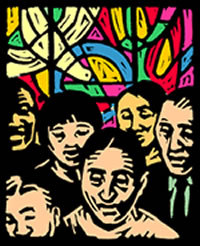
St John Lateran Basilica - November 9th
The official name of the basilica we honour is Church of the Most Holy Saviour – though it is commonly called St John Lateran. Because it is the cathedral church of the Bishop of Rome (who, in the words of the Church Fathers, ‘presides in love’ over the universal Church) its dedication is marked with a special honour, taking precedence over the normal Sunday liturgy. Places are important in our human experience; and sacred places feature prominently in the world’s religious traditions. Jerusalem’s temple was an outstanding symbol in the faith experience of old Israel. There, in the words of the psalms, God’s people ‘saw the face of God’. Ezekiel’s prophetic vision, in the first reading, gives expression to this tradition. Ezekiel, himself a priest of the temple, promises that it will be an even greater source of blessings for those who return after the exile.
Sometimes religious symbols are in danger of becoming more important for people than the things they symbolize. Today’s liturgy reminds us of this – the Church we believe in as we join in today’s celebration is not a magnificent Roman building, but a living temple, the Body of Christ, in which God has come to dwell. This is the message of the reading from John’s gospel. In the other gospels, the incident described here takes place in the final days of Jesus life, precipitating that hostility that was to lead to his death. John tells of this incident at the outset of the public life of Jesus, as an indication of the ultimate significance of the Saviour’s mission. Disrupting the normal life of the temple was far more than a rebuke for lack of reverence; it was a prophetic gesture. The temple and its worship are now to pass away; what they could only foreshadow is now to be realized in the person of Jesus. The disciples ‘remembered when Jesus rose from the dead’ John tells us – a phrase that sums up the meditative process that gave us the treasures to be found in the fourth gospel. In his Paschal Mystery, the Saviour inaugurated the world’s true worship of the Father, and he gives us to share in that worship through the solidarity we have with him, as a new and living place of worship, not made with human hands.
Magnificent interpreter of the work of the Saviour that he is, Paul spells out some of the implications of the truth expressed in the gospel passage: with Jesus Christ as the ‘foundation’, we are ‘God’s temple’; Paul and others, like him called by God, are God’s collaborators in the establishing and maintaining of the this temple of God’s eternal presence.
A final fascinating detail. Ezekiel’s vision of the waters of life flowing out from the right hand side of the temple had its inspiration in the waters that washed away the blood of old Israel’s sacrifices. The blood and water so solemnly described in John’s gospel, flowing from the pierced side of the saviour – from the new temple of his body – have long been seen by Christian tradition as a symbol of the sacramental blessings which are the life of the Church, given to the world in the Paschal Mystery.
John Thornhill sm

